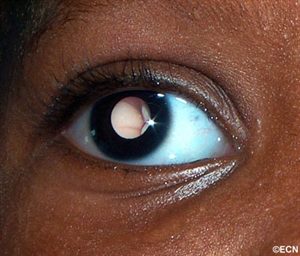Early screening for retinoblastoma in infants is key to saving vision and life.
Retinoblastoma is the most common intraocular childhood cancer. It affects approximately 300 children in the United States each year and more than 8,000 worldwide. When detected early, the cure rate is high. But if the diagnosis is delayed, it can result in the loss of an eye and even death.
In all cases, early screening is important to detect cancer in its beginning stages. Doctors should regularly examine the child’s eyes, and parents should be aware retinoblastoma symptoms. White spots appearing when light shines into the eye is the most common sign. This often shows up in flash photography. Other symptoms include a lazy eye, vision problems, redness in the white part of the eye, bulging eyes, changes in the color of the iris, and unequally reactive pupils.
The importance of screening is magnified in children with a family history of retinoblastoma. They need to be examined by an ophthalmologist immediately after birth. Regular examinations should be continued for the next 5 to 6 years, at least once every 3 to 6 months.
Genetic testing is another option for children with a family history of retinoblastoma.
“Genetic testing is so important in retinoblastoma, the American Joint Committee on Cancer RB-Section headed by Ashwin Mallipatna MD achieved approval for heredity to be included in the 8th edition AJCC RB Cancer Staging System,” notes Dr. Paul T. Finger, Chair of The AJCC Ophthalmic Oncology Task Force.
In India, the Orbit and Oculoplasty Clinic of Aravind Eye Hospital recently opened its Ocular Cancer Genetic Centre. India has the highest incidence of retinoblastoma in the developing world. According to an article in the Journal for Human Genetics, about 40% of Indian patients suffer from the hereditary form of RB.
“After providing treatment, prosthetic eye and rehabilitation for patients for years, the question of what we could do to prevent RB kept haunting us. If we are able to see the tumor early, we can save the life of the child. But if we find out the predisposition to RB from gene mutation in either of the parents, we can save both vision and life of the child,” Usha Kim, chief, Orbit, Oculoplasty and Oncology Clinic, told The Hindu.
Mutations in the RB1 gene are responsible for hereditary retinoblastoma. Due to the gene’s large size and complexity, genetic testing can be cumbersome. To overcome the problem, researchers in India developed a rapid screening strategy by prioritizing sections of the DNA.
“Using this strategy for genetic analysis, mutations were identified in 76% of patients in half the actual time and one third of the cost. This reduction in time and cost will allow for better risk prediction for siblings and offspring, thereby facilitating genetic counseling for families, especially in developing countries.”
Advances in genetic testing will make screening more widely available, especially in developing countries. Children with family histories of retinoblastoma should undergo genetic screening when possible. But nothing can replace diligent doctors and parents being aware of the symptoms, and making sure children get regular eye examinations.











miRNA18a as biomarker in serum is used for screening retinoblastoma: PSGIAS and Sankaranethralaya-Salim B, Merlin David S, Beta M, Narayanan J, Krishnakumar S, et al. (2015) PMMA Platform Based Micro Fluidic Mixer for the Detection of MicroRNA-18a from Retinoblastoma Serum. J Anal Bioanal Tech 6:258. doi: 10.4172/2155-9872.1000258